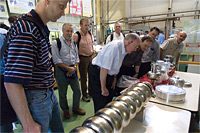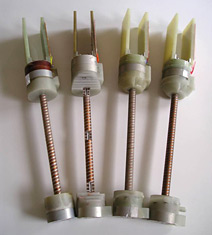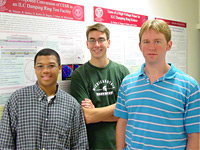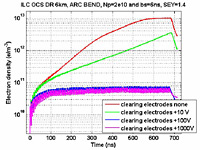| TTC Meeting held at KEK |

The TTC brings experts from around the world together to solve the challenges of superconducting technology for the ILC. |
|
From 25-28 September, 101 accelerator physicists from around the world attended the TESLA Technology Collaboration Meeting at KEK in Japan. "After the technology choice [for the linear collider cavity] was made, the TESLA collaboration as a collaboration advancing the linear collider was no longer needed, but the technology pool was considered to be very important," said Albrecht Wagner, director of DESY. "Therefore the TESLA Technology Collaboration was created to pool all the know-how of superconducting accelerator technologies, cavity development, and cavity preparation up to the full accelerator." The last TTC meeting was held at INFN-Frascati in December 2005.
Read more...
-- Youhei Morita |
|
 |
|
|
 |
|

This photo shows the family of four 30-cm prototype superconducting
helical undulators constructed by the Helical Collaboration in the UK
(Daresbury Laboratory, Rutherford Appleton Laboratory, University of
Liverpool, University of Durham and DESY). Eventually the ILC will need
an undulator of about 100 m to generate the required number of
positrons. The excellent magnet test results from these first short
prototypes were presented for the first time at last week's ILC Positron
Source Group Meeting.
|
|
 |
Students Contribute to ILC Damping Ring Studies at Cornell University

(Left to Right) Students Joseph Burrell, Jim Shanks and Michael Ehrlichman spent their summer in the Laboratory for Elementary-Particle Physics at Cornell University, contributing to R&D for the CESR test facility. |
Between electron cloud concerns, ultra-low beam emittance requirements and a handful of wigglers, you might say that the damping rings in the International Linear Collider are high maintenance. In the ILC, the 6-kilometre round damping rings will transform loose bunches of electrons and positrons into tight, disciplined beams before their final acceleration toward the interaction point at the center of the machine. It sounds easy enough, but fine-tuning the beams to be less than the thickness of a human hair is an extremely complex and challenging task.
Read more...
-- Elizabeth Clements |
 |
|
|
 |
From Interactions News Wire
3 October 2006
George Smoot Wins Nobel Prize In Physics
George F. Smoot, 61, leader of a research team that was able to image the infant universe, revealing a pattern of miniscule temperature variations which evolved into the universe we see today, has been awarded the 2006 Nobel Prize for physics.
Read more... |
|
From The MathWorks
October 2006
Research Engineers Advance Design of the International Linear Collider with MathWorks Tools
The International Linear Collider (ILC) is expected to enable researchers and particle physicists to answer questions about the origins of mass, the existence of additional dimensions in the universe, and the nature of gravity.
Read more... |
|
From The Globe and Mail, Toronto, Canada
30 September 2006
Physics at the end of its string?
...What physics desperately needs is not new ideas but hard experimental
data that can test ideas or inspire new ones. But these data are costly.
Read more... |
|
From Cosmos Magazine
29 September 2006
Particle wobble shakes up supersymmetry
The barely detectable wobble of a short-lived particle with the unlikely name of Bs meson could challenge current theories about how the universe is constructed, according to an international team of particle physicists.
Read more... |
|
|
 |
 |
|
|
 |
The Evolving ILC Design: Eliminating One Positron Damping Ring

Electron Cloud build-up and suppression using clearing electrodes. |
We have planned from the beginning to quickly create an initial baseline and as a result of technical developments, evolve it in time. Our Baseline Configuration Document explicitly includes a number of alternatives that we consider to be very good candidates for replacing the baseline as soon as more R&D or technical studies have been completed. Based on one such technical development, we recently changed the baseline by eliminating one of the two positron damping rings. Our original baseline used two damping rings that received alternate bunches. The resulting longer bunch spacing reduced the problem of electron cloud effects; however this was a complicated and expensive solution. New studies of alternate methods for mitigating electron cloud effects have given us enough confidence to eliminate one positron ring. This action saves an entire damping ring and thereby realises a significant cost savings.
Read more...
-- Barry Barish
Director's Corner Archive |
 |
|
|
 |
Got a story?
Have you just reached a major milestone? Or do you just have an interesting story from your lab? Maybe you have a new graduate student or Postdoc working for you? Send us your story ideas for ILC NewsLine at communicators@linearcollider.org.
Register for ILC-Valencia '06
ILC-ECFA and the GDE will host a joint meeting in Valencia, Spain on 6-10 November 2006. The registration deadline is on 6 October.
Learn more... |
|
ILC-Related Preprints
hep-ph/0610020
2 Oct 2006
Discovery potential of radiative neutralino production at the ILC
hep-ph/0610005
30 Sep 2006
Signals of the littlest Higgs model with T-parity at eγ and ep collisions
hep-ph/0609307
29 Sep 2006
Experimental tests for the Babu-Zee two-loop model of Majorana neutrino masses
physics/0609248 and EUROTeV-Report-2006-083
28 Sep 2006
Design of an interaction region with head-on collisions for the ILC |
|
EUROTeV-Report:
EUROTeV-Report-2006-055
Numerical Calculations of Collimation Insertions |
|
|

